- Home
- The Autumn Garden
- Fall Perennials P-Z
Fall Perennials P - Z
A continuation of the list of fall perennials.
Patrinia villosa, patrinia, Zones 5-8. Patrinia has tiny white flowers that float above the foliage giving a lacy effect to the border. A nice plant to interweave with others.
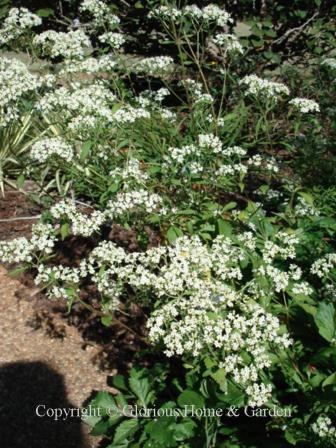 Patrinia villosa
Patrinia villosaPersicaria amplexicaulis, mountain fleece, Zones 4-7. This plant caught my eye when I spotted it recently at the Berkshire Botanical Garden in Stockbridge, MA because I haven't seen it growing in the Atlanta area. It really stood out against a dark background with its little bottle-brushes of crimson flowers rising above a sea of green leaves. Long bloom period.
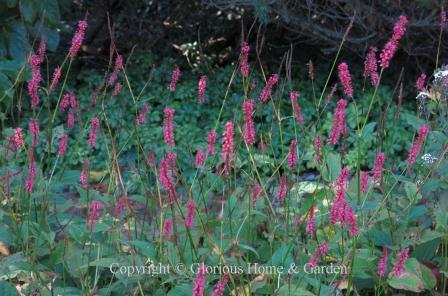 Persicaria amplexicaulis
Persicaria amplexicaulisPhlox paniculata, garden phlox, Zones 4-8. Phlox paniculata is certainly of one of the mainstays of the summer garden, but it will often continuing blooming into fall. 'Franz Schubert,; lavender; 'Jeana,' lavender-pink and mildew resistant, and 'World Peace,' white, are a few late season bloomers.
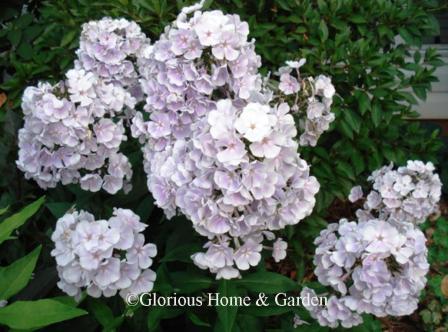 Phlox paniculata 'Franz Schubert'
Phlox paniculata 'Franz Schubert'Plectranthus 'Mona Lavender', Swedish ivy, Zones 10-11. The dark green leaves with purple undersides are attractive, and the tubular lavender flowers are lovely and bloom over a long period in summer, but they bloom more profusely and the color seems to intensify with the approach of cooler weather. Best grown as a houseplant, in containers or as a summer bedding plant north of Zone 10. I overwinter mine in the garage and bring them back out in spring after danger of frost is past.
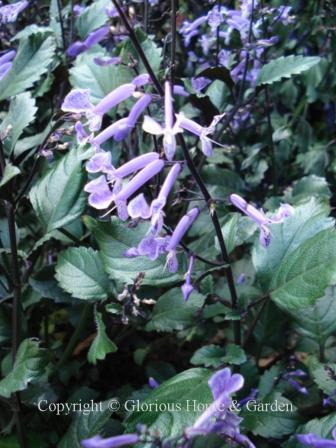 Plectranthus 'Mona Lavender'
Plectranthus 'Mona Lavender'Ricinus communis, castor bean, Zones 8-11. Castor oil is derived from the seeds of this plant which can grow to a small tree in frost-free zones, but is usually used as an annual. As a fall curiosity, it can be highly ornamental with huge tropical looking palmate leaves and interesting prickly seed pods. There are some named cultivars that are particularly ornamental. However, all parts of this plant are highly toxic (especially the seeds) and should not be planted where there are children about.
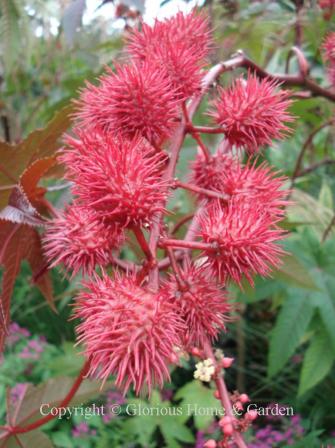 Ricinus communis
Ricinus communisRudbeckia nitida 'Herbstsonne', shining coneflower, Zones 5-9. This tall (5-7') late summer into fall perennial has golden yellow slightly drooping petals surrounding a raised green dome-shaped center. Planted at the back of the border with other tall fall stars like Joe Pye Weed and asters, 'Herbstsonne' is a standout.
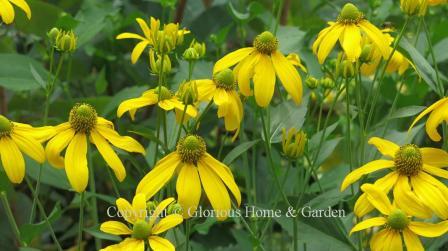 Rudbeckia nitida 'Herbstsonne'
Rudbeckia nitida 'Herbstsonne'Salvia
There are so many great salvias to choose from, one could use them as the foundation plants for a great perennial border and have blooms from spring to frost.
Salvia azurea var. grandiflora, azure or prairie sage, Zones 5-9. This North American native has the benefit of being a fall-blooming perennial, but most of all it has the most glorious blue flowers! Drought tolerant.
Salvia elegans, pineapple sage, Zones 7-10. A delightful fall perennial on many levels--the crushed leaves really do smell like pineapple, and the red tubular flowers bloom late in the season and continue until stopped by frost attracting any late bees and butterflies. It is beloved by hummingbirds. In my Zone 8a garden it dies to the ground in winter and reappears in spring, north of Zone 7 it may be killed by frost before it can bloom.
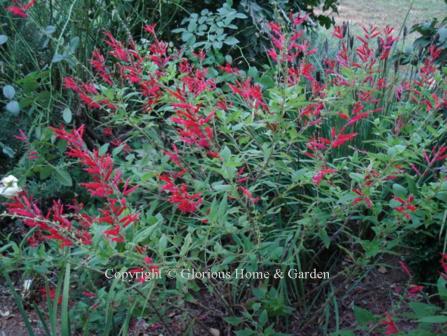 Salvia elegans
Salvia elegansSalvia greggii, Texas or autumn sage, Zones 7-10. Native to Texas, this shrubby sage grows 2-3' and blooms over a long period from spring to fall, are drought tolerant, and hummingbirds love them. There are lots of colors available including white, pink, yellow, coral, rose, red, violet, and bi-colors. The "HeatWave" series is good (said to be a cross between S. greggii and S. microphylla) for its long bloom period and clear colors. 'Heat Wave ™ Scorcher' shown below.
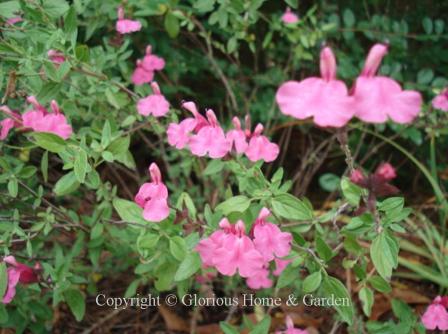 Salvia greggii
Salvia greggiiSalvia guaranitica, blue anise sage, Zones 7-10. One of my favorite perennials, fall or otherwise, blue anise sage blooms from late spring into fall. 'Black and Blue' is an excellent cultivar with outstanding blue flowers and deeper blue, nearly black, calyxes. This subshrub can get huge--as much as 6' tall--and blooms through summer into autumn. The intense blues are excellent combined with fall yellows and oranges also, and hummingbirds preparing for their fall migration really appreciate it. ‘Amistad’ (purple), ‘Argentina Skies’ (light blue), ‘Black and Bloom,’ as well as ‘Black and Blue’ are all great selections.
× 'Indigo Spires,' Zones 7b-10. 'Indigo Spires' is a fantastic hybrid, very vigorous, and reaching about 4' in height. The long blooming period (summer to frost) is one of its most appreciated traits, and the intense violet-blue of the flowers on long, twisting, spike-like inflorescences are very showy and really make in impact in the garden. Pinch off spent flower spikes to keep it tidy and blooming away. One of my favorites!
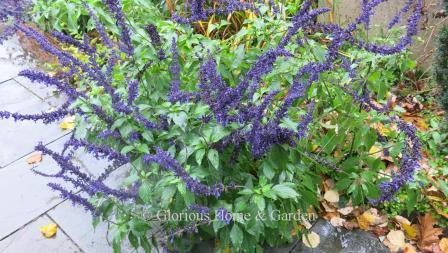 Salvia 'Indigo Spires'
Salvia 'Indigo Spires'Salvia leucantha, velvet sage or Mexican bush sage, Zones 7b-10. Mexican bush sage is treated as a tender perennial or annual in most areas. It flowers profusely from early summer until stopped by frost, producing many spikes of velvety white flowers extending from a lavender calyx. The narrow gray-green leaves are soft as well. Easy to grow in full sun and drought-tolerant.
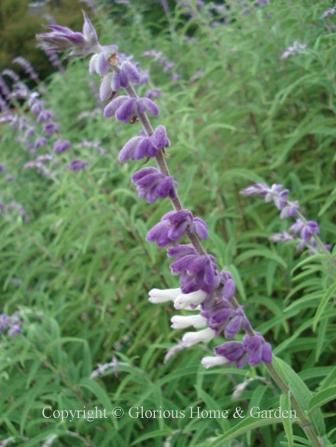 Salvia leucantha
Salvia leucanthaSalvia regla, mountain sage, Zones 8-11. This sage from Mexico blooms in late summer in an intense orange-red. A real stand-out in the autumn garden. 'Jame' is shown below.
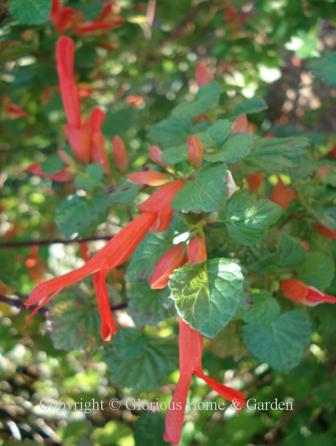
Salvia uliginosa, bog sage, Zones 6-9. Bog sage produces beautiful sky blue flowers on 3-6' plants from summer until frost on 3-6' plants. Growing in wet places in its native habitat, bog sage does well in ordinary well-drained garden soil in light shade--sometimes too well--the plant spreads by underground runners and can become invasive.
Salvia splendens 'Van Houttei,'
wine sage, Zones 8-10. Lovely burgundy flowers from summer into fall.
A tender perennial that can be treated as an annual outside of its
range, or cuttings can be taken to overwinter in a greenhouse. 'Paul,' shown below, is a deep wine cultivar. Works well with Agastache rupestris 'Tutti Frutti' and fall-blooming ageratums.
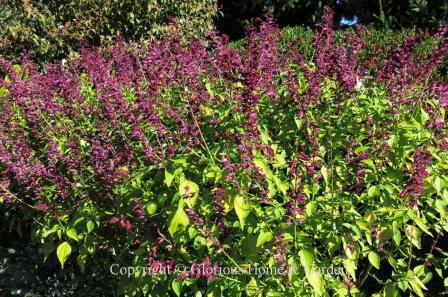 Salvia spendens 'Van Houttei'
Salvia spendens 'Van Houttei'Sedum (See Hylotelephium)
Solidago × hybrida, goldenrod hybrids, Zones 4-9.
While goldenrods are a common roadside wildflower in North America in
late summer and fall, we haven't been too keen to use it in our gardens.
Probably because most of them grow quite tall and look sort of, well,
weedy when not in bloom. They also have the undeserved reputation for
causing hayfever (actually ragweed). But in the wild they can make
spectacular displays with their showy golden yellow plumes. Cultivars
are being developed that make this native wildflower more manageable and
refined for our gardens. S. sphacelata 'Golden Fleece' is a
dwarf (15-20"), 'Crown of Rays' grows 2' tall and has thick feathery
plumes, 'Little Lemon' grows compactly to 12-18" with lemon yellow
flowers, and S. rugosa 'Fireworks' grows to 3' and will light up your garden with long arching sprays of gold. Do include one of more of these outstanding fall perennials in your garden.
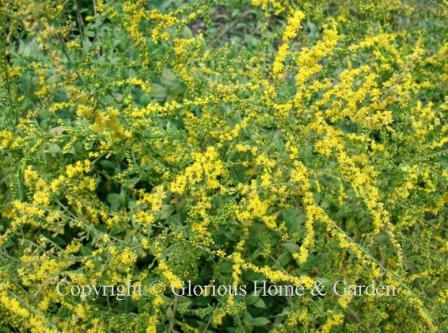 Solidago rugosa 'Fireworks'
Solidago rugosa 'Fireworks'Symphyotrichum novae-angliae, New England aster (also called Aster novae-angliae), Zones 4-8. No fall garden should be without at least one of these tall fall perennials (4'-6'). These beauties are so smothered in small rayed flowers that they benefit from staking. Cultivars include 'Alma Potschke,' red-pink; 'Lyon's White,' white; and 'Purple Dome,' purple.
Symphyotrichum oblongifolium, aromatic aster, Zones 5-9. This aster relative has gotten a lot of attention lately for its beautiful blue-with-a-hint-of-lavender flowers with yellow centers that bloom profusely in autumn. The foliage is aromatic when crushed. Unlike the tall asters, this one is low-growing and spreads by rhizomes to form a large clump. 'English Countryside,' 'October Skies,' 'Rachel Jackson,' and 'Raydon's Favorite' are good cultivars of this North American native wildflower.
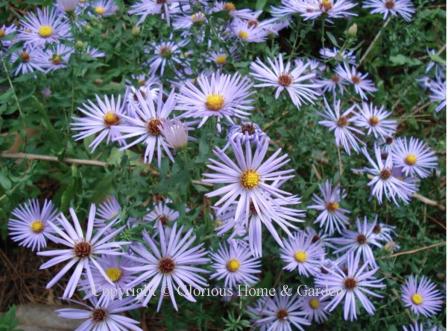 Symphyotrichum oblongifolium
Symphyotrichum oblongifolium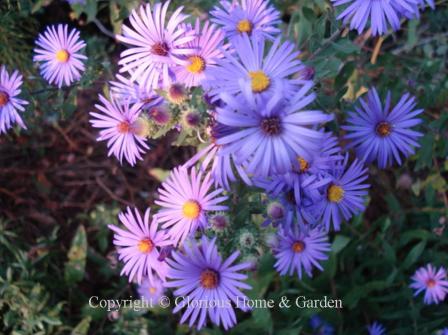 Symphyotrichum novae-angliae 'English Countryside'
Symphyotrichum novae-angliae 'English Countryside'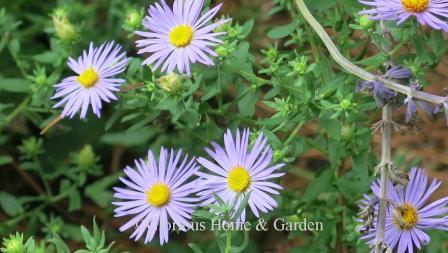 Symphyotrichum oblongifolium 'Raydon's Favorite'
Symphyotrichum oblongifolium 'Raydon's Favorite'Tricyrtis--Toad Lilies
Tricyrtis formosana, toad lily, Zones 5-8. This one holds it's speckled flowers on the ends of long stems as well as in the leaf axils. 'Samurai' is a lovely cultivar with purple flowers and
cream-edged variegated leaves. It begins blooming in late August and continues into
fall, and as it spreads by rhizomes (but
not aggressively), it will soon make a lovely colony. Lovely fall perennials to edge a path in the shade garden!
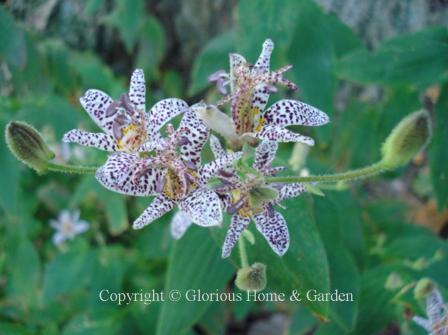 Tricyrtis formosana
Tricyrtis formosana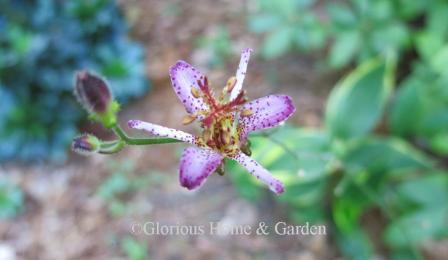 Tricyrtis formosana 'Samurai'
Tricyrtis formosana 'Samurai'Tricyrtis hirta, toad lily, Zones 4-8. Toad lilies are delightful in the late summer and fall shade garden--and they are certainly more beautiful than their common name. T. hirta produces lilac flowers in the leaf axils held on top of long arching stems from late summer to mid fall.
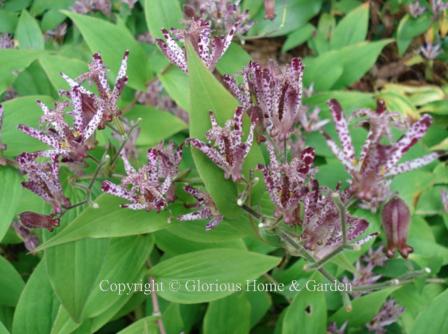 Tricyrtis hirta
Tricyrtis hirtaTricyrtis macropoda, toad lily, Zones 5-8. Toad lilies are wonderful plants for autumn flowers in a shady, moist garden. T. macropoda has an upright growth habit that shows off the flowers well.
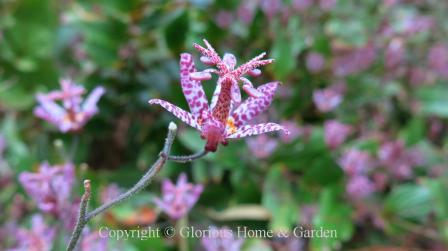 Tricyrtis macropoda
Tricyrtis macropodaVernonia noveboracensis, New York ironweed, Zones 5-8. This is a tall (3-7') plant that does well in the back of the border in full sun. The purple flowers bloom in late August to September and combine well with the yellows of goldenrod and helianthus.
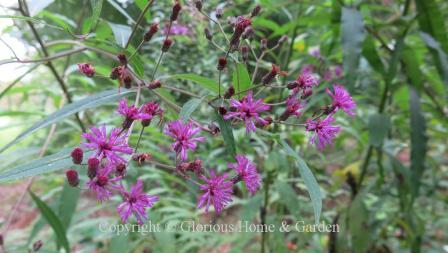 Vernonia noveboracensis, New York ironweed
Vernonia noveboracensis, New York ironweed
Plant of the Month
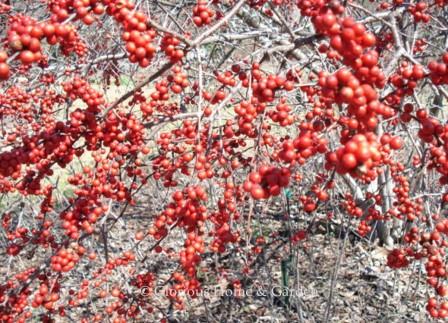
Ilex verticillata
Winterberry holly
Updated new USDA Plant Hardiness Zone Map 2023.